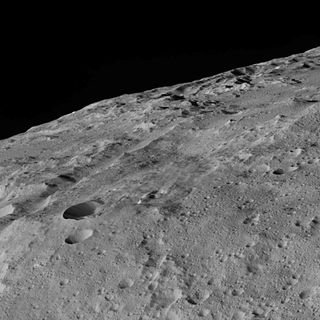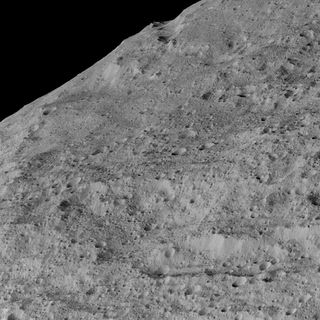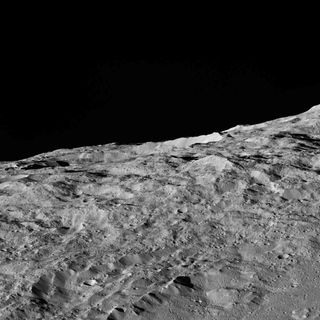Dwarf Planet Ceres' Stretched-Out Surface Revealed in New Photos

NASA's Dawn probe took a series of stunning new images of Ceres' chain of craters called Gerber Catana, from an altitude of just 240 miles (385 kilometers) – the closest the spacecraft has ever come to the dwarf planet.
Among the major science findings from the close-up view is the discovery that Ceres, despite its diminutive size (only about 590 miles wide, or 950 km), displays internal stresses similar to what you would find on a larger body, such as Mars. Grooves and troughs on the surface of Ceres were mostly created after meteorite impacts, but some are shaped in a way that suggests tectonic forces.

"Why [the groves and troughs] are so prominent is not yet understood, but they are probably related to the complex crustal structure of Ceres," said Paul Schenk, a Dawn science team member at the Lunar and Planetary Institute in Houston, in a statement.
Dawn's backup framing camera snapped the images to test out its capabilities. The primary camera is also working perfectly and began taking pictures at this altitude Dec. 16.
Meanwhile, Dawn is looking for signatures of minerals and various elements on Ceres using an onboard instrument called the visible and infrared mapping spectrometer (which detects light reflected off the surface) in concert with the gamma-ray and neutron detector (which looks for components of nuclear radiation), the statement said.

Get the Space.com Newsletter
Breaking space news, the latest updates on rocket launches, skywatching events and more!
The $466 million probe left Earth in 2007, made a stop at another large body in the asteroid belt, Vesta, and arrived at Ceres last March.
A few weeks ago, the Dawn spacecraft may have finally solved a particularly perplexing mystery of Ceres: Observations by the probe showed that mysterious bright spots on the dwarf planet's surface are likely salt deposits.
"As we take the highest-resolution data ever from Ceres, we will continue to examine our hypotheses and uncover even more surprises about this mysterious world," said Chris Russell, principal investigator of the Dawn mission who is based at the University of California, Los Angeles.
Follow Elizabeth Howell @howellspace. Follow us @Spacedotcom, Facebook and Google+. Original article on Space.com.
Join our Space Forums to keep talking space on the latest missions, night sky and more! And if you have a news tip, correction or comment, let us know at: community@space.com.

Elizabeth Howell (she/her), Ph.D., is a staff writer in the spaceflight channel since 2022 covering diversity, education and gaming as well. She was contributing writer for Space.com for 10 years before joining full-time. Elizabeth's reporting includes multiple exclusives with the White House and Office of the Vice-President of the United States, an exclusive conversation with aspiring space tourist (and NSYNC bassist) Lance Bass, speaking several times with the International Space Station, witnessing five human spaceflight launches on two continents, flying parabolic, working inside a spacesuit, and participating in a simulated Mars mission. Her latest book, "Why Am I Taller?", is co-written with astronaut Dave Williams. Elizabeth holds a Ph.D. and M.Sc. in Space Studies from the University of North Dakota, a Bachelor of Journalism from Canada's Carleton University and a Bachelor of History from Canada's Athabasca University. Elizabeth is also a post-secondary instructor in communications and science at several institutions since 2015; her experience includes developing and teaching an astronomy course at Canada's Algonquin College (with Indigenous content as well) to more than 1,000 students since 2020. Elizabeth first got interested in space after watching the movie Apollo 13 in 1996, and still wants to be an astronaut someday. Mastodon: https://qoto.org/@howellspace
